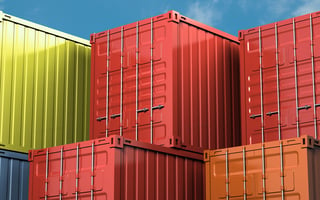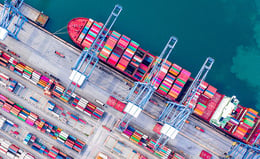TPP and Supply Chain Agility: What You Need to Know
Nick Ostdick - March 29, 2016

One of the biggest and still most mysterious headlines of 2015 was the approval of the Trans Pacific Partnership this last October. The 12-country agreement was finally reached after more than seven years of negotiations, creating a more open trade network for goods services and to promote worldwide growth in manufacturing and labor.
 The agreement will lift restrictions on trade between the member countries – including Peru, Vietnam, Mexico, Japan, and others – and will allow for easier trade, simplified taxation and tariffs, and greater transparency of the transfer of goods and services between countries.
The agreement will lift restrictions on trade between the member countries – including Peru, Vietnam, Mexico, Japan, and others – and will allow for easier trade, simplified taxation and tariffs, and greater transparency of the transfer of goods and services between countries.
This is not such a mystery. But what remains mysterious and a subject of debate is how the TPP will impact global supply chain logistics and the ability of companies to compete in what appears to be a game-changing agreement. Here’s what many supply chain industry insiders do know about the TPP and how it will affect supply stream processes in the years to come:
- New markets: Within the 12-member countries exists new markets for U.S. and foreign suppliers to provide products at lower costs and greater volume than ever before. These new markets also present manufacturers and suppliers with interesting new opportunities to create and position new or existing products in such a way that appeals to these new markets, which will likely require new or updated production and sales strategies.
- Increased demand: Countries like Peru, Vietnam, Japan, Chile, and Malaysia are forecasted to increase demand for parts and products on a fairly large scale as they enter a more global trading pool. This spike in demand could be a boon – or perhaps even a disadvantage, as we’ll see in a moment – to manufacturers and suppliers in attaining new customers and reaching new levels of growth and profitability.
- Competition: With a host of new countries suddenly interacting on a more level playing field, competition for products will likely see a significant increase as manufacturers and suppliers in the TPP-member countries jockey for prime position in terms of costs, supply, inventory and sales. In addition, competition for resources such as fuel, packaging materials, and other vital elements in the supply chain process will likely become stiffer as these new markets require greater shares of the available resources to meet demand.
With these implications in mind, SCPs the world over would be well-advised to consider whether their supply chains are equipped to handle what could be a seismic shift in the global supply chain landscape. Supply chain agility and resiliency will be key factors in determining which companies succeed under the TPP and which struggle to keep pace.
 For example, say an automotive parts manufacturer in Chile experience exponential demand for products in Malaysia as a result of lower taxes and tariffs. The ability to leverage integrated, smart supply chain solutions will be critical for this manufacturer in filling orders, inventorying supply, and seamlessly transporting more product to perhaps a previously unshipped hub.
For example, say an automotive parts manufacturer in Chile experience exponential demand for products in Malaysia as a result of lower taxes and tariffs. The ability to leverage integrated, smart supply chain solutions will be critical for this manufacturer in filling orders, inventorying supply, and seamlessly transporting more product to perhaps a previously unshipped hub.
Or, alternatively, imagine a company discovers a new market for products in Vietnam, a country which they have yet to distribute. In very little time, this company will have to establish a cost-effective shipping route, steady stream of supply, and methods to port and warehouse data to ensure obligations are met and a new market does not become a drain on a company’s liquidity and growth.
Supply chain agility and the ability a SCP has to maneuver costs, products, and analytics within a supply stream to ensure success in the TPP age will come down to a few simple, yet wholly integral factors.
- Communication: 12 member countries, all of which spread out across the globe, in locales with their climate, socio-political, and labor conditions. These factors alone should make the case for why clear, expedient communication across all supply chain points will be valuable in creating an efficient stream of products. Easy, effective communication and collaboration both internally and externally will also foster greater visibility along the supply chain and help SCPs to identify potential breakdowns before they hit the supply chain.
- Real-time reporting/data: Big Data, the Internet of Things, Industry 4.0. We’ve heard these concepts before and know their value, but as TPP-member countries begin shipping products between their borders, the ability to capture real-time data, analyze it, and use it to make on-the-fly decisions will be a pillar of supply chain agility. Spreadsheets and other antiquated ways of tracking inventory and shipping data simply won’t be of use when dealing with differing time zones, languages, climates, and other elements that will undoubtedly factor into new supply chain paradigms.
- Forecasting: With more players on the field, so to speak, so much of supply chain agility will depend on manufacturers, suppliers, and distributors to be able to make detailed, accurate forecasts and models to help gauge the appropriate levels of supply, inventory, and freight. If we think back to our two earlier examples of the Chilean and Vietnamese companies, it’s difficult to imagine these companies maintaining cost-effective and growth-enabling practices without being able to make educated preparations for whatever supply chain disruptions they may encounter.
Editorials have abounded in trade and industry journals as of late speculating on whether the TPP will be a force for good or cause detriment to the global trading and manufacturing sector, and those in the know can adequately argue both sides of the issue. But when it comes to globalized supply chain logistics, everyone agrees big changes are afoot, and a company’s ability to be agile and resilient in these changing times may make the difference between seizing new opportunities and growth or getting left behind.
LATEST POSTS
- Understand Circular Economy in The Manufacturing Industry
- How Can Industry 4.0 IT Integration Be Achieved Smoothly?
- The Significance of Order Sequencing in Discrete Manufacturing
- How to improve your Supply Chain Management: The Power of Control Towers
- Optimizing Human Resource Scheduling in Manufacturing: A Technological Approach



